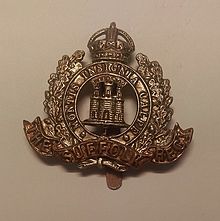Suffolk Regiment
| Suffolk Regiment | |
|---|---|

Badge of the Suffolk Regiment
|
|
| Active | 1685–1959 |
| Country |
|
| Branch |
|
| Type | Infantry |
| Role | Line infantry |
| Size |
1–2 Regular battalions |
| Garrison/HQ | Gibraltar Barracks, Bury St Edmunds |
| Nickname(s) | "Old Dozen" |
| Engagements |
Battle of Minden Eureka Rebellion Battle of Singapore |
1–2 Regular battalions
1–2 Militia and Special Reserve battalions
1–4 Territorial and Volunteer battalions
The Suffolk Regiment was an infantry regiment of the line in the British Army with a history dating back to 1685. It saw service for three centuries, participating in many wars and conflicts, including the First and Second World Wars, before being amalgamated with the Royal Norfolk Regiment to form the 1st East Anglian Regiment (Royal Norfolk and Suffolk) in 1959 which, in 1964, was further amalgamated with the 2nd East Anglian Regiment (Duchess of Gloucester's Own Royal Lincolnshire and Northamptonshire), the 3rd East Anglian Regiment (16th/44th Foot) and the Royal Leicestershire Regiment to create the present Royal Anglian Regiment.
The regiment was raised by Henry Howard, 7th Duke of Norfolk as the Duke of Norfolk's Regiment of Foot in 1685 and incorporated men from the East Anglian counties of Norfolk and Suffolk. It was originally formed to combat the Monmouth Rebellion, but was not disbanded when the rebellion was defeated. Following the 1688 Glorious Revolution its Colonel Lord Lichfield was dismissed for his sympathies with James II and was replaced by Henry Wharton. Under Wharton the regiment participated in Marshal Schomberg's expedition to Ireland in 1689. It captured the unoccupied town of Belfast and then took part in the Siege of Carrickfergus in August 1689. Wharton died of fever in October 1689 while the regiment was part of the Dundalk Camp. Richard Brewer took command of the regiment and led it at the Battle of the Boyne in July 1690, the Capture of Waterford in July 1690 and the Siege of Limerick in August 1690. The regiment also fought at the Siege of Athlone in June 1691 and the Surrender of Limerick in August 1691 before returning to England later in the year.
...
Wikipedia
